High Caliper Page 2
![]() Ready To Rock
Ready To Rock
First impressions can be helpful, but in some cases the reverse is true. A speaker may start quite badly but finish well, proving capable of providing longer term satisfaction, and in the case of the Caliper our first feelings were not particularly positive. Despite the use of a substantially good front-end and considerable care taken with setting up, the sound was found to be lacking in several areas, although it was well focused in a general sense, and gave pleasing stereo.
Take perceived coloration. The Caliper sounded odd on orchestral strings, but the effect is hard to describe; it appeared to emphasise the wrong parts with a touch of nasality. Not sufficiently 'open', the presence-band lacked life, while upper-range harmonic sparkle was also subdued, suggesting a weak final octave. In the Apogee mould, the bass was strong, and in my room the Caliper delivered a thumpy, thudding quality which proved impressive on some rock material.
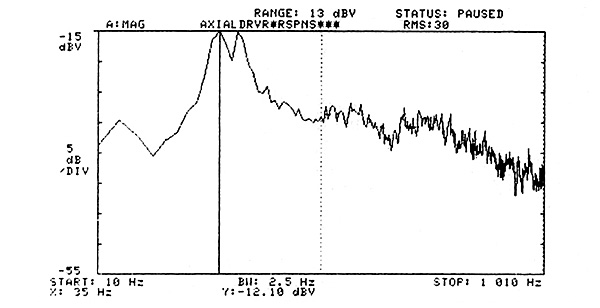
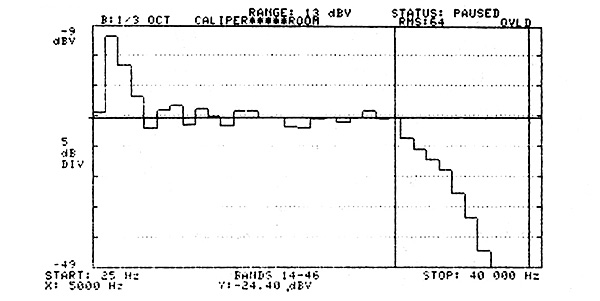
Comparing this with my recollections of the Duetta, both it and the Caliper have a heavily down-tilted frequency characteristic; but the Caliper is definitely lighter-textured and faster-sounding, yet not at the expense of any fatiguing emphasis. Both designs possess strong bass, but the Duetta's power appears at a lower frequency and is thus richer and less thumpy than the Caliper. Both models show a similar roll-off above 12-13kHz, reducing the impression of 'air'. (This characterisation is quite pertinent, since distance in air does impart a treble roll-off.)
Music Maestro
As the speakers settled in, the dynamics were appreciated, the sound being remarkably unforced, yet carrying dynamic contrasts and musical edges with consistent accuracy and subtlety. Stereo focus was in the 'panel tradition', being a little larger-than-life and not as concentrated as that provided by smaller box speakers. But it was impressive in its scale, coherence, stability and solidity, while phasey effects were minimal. Wide frontal imaging was possible, though the soundstage was 'darkened', and perceptibly narrowed to the rear.
In general terms the bass was very fine, sounding fast, powerful and articulate, while displaying very low distortion and minimal upper band coloration or emphasis. But it was clearly exuberant, leading to the thumpy quality noted above, centred on the sound produced by a moderately damped kick-drum.
Again to a good standard, the mid register demonstrated an intrinsically high level of musicality, even if it was flawed by a tonal imbalance associated with a depression in the lower presence range below 3kHz, as well as the moderate nasality. The latter helped sharpen it up a little, but the mid lacked a faithful inner balance.
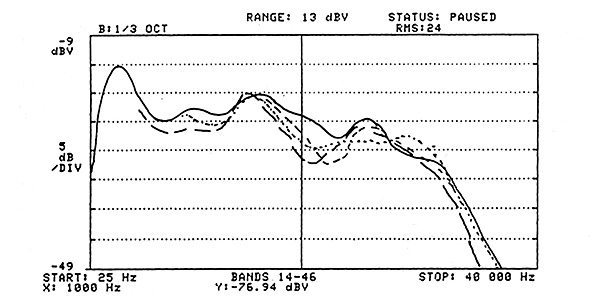
The treble was above average, but not, in my view, in the Scintilla class, and ultimately suggested that the Kapton used was not a perfect substitute for (and could not replicate the transparency and extension of) a pure metal foil. In absolute level the treble was subdued, and could also have provided more detail and tonal discrimination. Conversely, it was rather better than that provided by the majority of soft-dome treble units.
While clearly insensitive, the Caliper withstood high input powers and showed no audible sign of compression up to 200W/channel, though particularly heavy bass drive could flap the diaphragm gently at around 150W peak-programme. Indeed, it thrived on generous power inputs. The main listening tests were conducted in the bi-wired mode. Single-wire working should thus be avoided if possible.
In the event, I confess to liking the Apogee Caliper despite its weaknesses. Like several other panel loudspeakers, this one was inherently musical, and given careful setting up and system-matching was capable of good results. Indeed, it offers a taste of greatness for a comparatively affordable, if still expensive, speaker, and for many this will be a full-range ribbon at a price they are prepared to pay.
![]() Ken Listens
Ken Listens
Part of Apogee's master plan has always been to satisfy the affordable end of the market as well as the top-end. If you've followed the company's progress, you'll note that it has lowered the cost with each successive model since the original seven-footer to the point where Apogee ownership is now down to half the cost of the Scintilla.
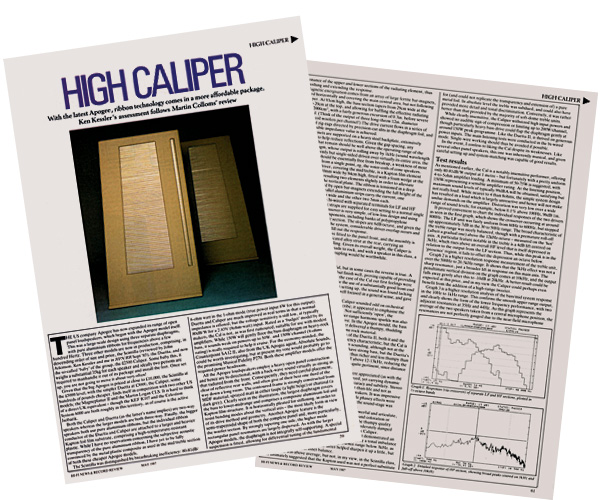
The Caliper, which I first heard in prototype form in March 1986, eliminates one of the problems encountered with both the Scintilla and Duetta, in that it is much smaller, being roughly of the same dimensions as the Quad.
Considering that the Quad is one of the UK's 'standard' loudspeakers, and hardly taken to task for its size, I don't want to hear any nonsense about the Caliper being too large for the British household. It takes up no more floor space than a medium-sized box on a stand.
Substituting the Calipers for a pair of February 1987 production Scintillas – still tough for one person to lift, even though they are half the weight of their big sister – I found that the positioning was slightly less critical, but still requiring painstaking care if you want to get that perfect balance between soundstaging and bass quantity.
Yes, the Caliper delivers gobs of bass, but it's a fine line between just right and too much. Pull them far enough away from the walls to reduce the bass, and you upset the focus. Position them too close, and you get boom-boom up the kazoo.
Optimum positioning in my room was in the same line as the Scintilla, with slightly less toe-in. Final fine-tuning for the bass was a substitution of Symo speaker cable for the various makes I'd tried, tightening up the bass while retaining Stygian extension. It was time to party.
Pleased As Punch
Driven by Krell KMA 100s, the Calipers conveyed power with almost as much confidence and force as the Scintillas. All of the dynamic capabilities of the Scintilla remained, save for the last amount of contrast at the extreme bottom. I know that the difference between these two loudspeakers is only a few Hertz in the lower registers, but the evidence is a shade less weight. Still, this is trivial, as the Caliper betters anything else I've heard in this region bar the larger Apogee designs. If anything, the Caliper will find friends with those who deem the Scintilla to be too bottom-heavy.
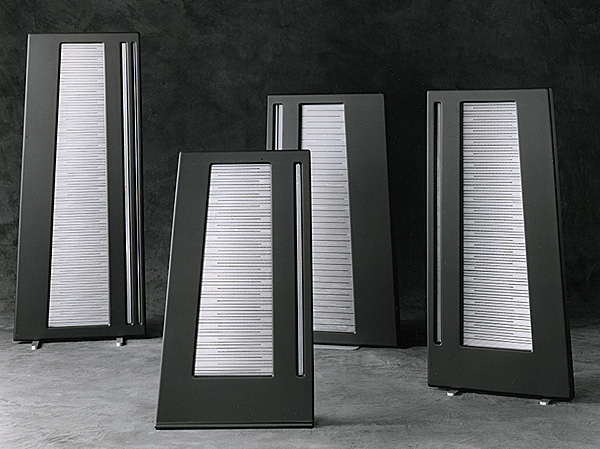
It's around the lower midrange where the Caliper veers from the path taken by the Scintilla, and in two key areas. The family resemblance is too strong for anyone to mistake the Caliper for anything other than an Apogee product, but the Caliper is a more forward, punchy speaker. The Scintilla grows on you; you 'learn' its sound. The Caliper lays its cards on the table, and you either embrace its up-front display or go back to the bank manager for another £2.5k.
Tonally, I didn't find any shocking change; the only contrasting characteristic is one of perspective, with the Caliper bringing the listener that much closer to the front row. I like to listen in the near-field, so it's natural that I would prefer the distancing effect of the Scintilla. Were my room suddenly to expand, I could move down to the Caliper with little sense of sacrifice regarding rnidrange performance.
The top-end is a slightly different story, with the Caliper actually improving on one aspect of the early Scintilla, and almost tying with the current-production Scintilla. The top-end, despite the forwardness of the upper-mid, remains sweet and non-aggressive, and I found it quite open and airy, in contrast to MC's findings. I can only attribute this alternative opinion to the use of systems differing in all but the choice of power amplifiers and widely differing room conditions.
Spoiled Rotten
Creating a scaled-down version of a flagship model is one of the toughest feats a manufacturer may face. The Caliper is most assuredly a 'miniature' Scintilla in that it offers the speed and transparency which so distinguishes this design from all other types, retaining its stereo focus and imaging properties. Sacrifices are limited to a shift in the positioning of the sonic picture, a minuscule loss of bass energy, and a slight loss of resolution in the extreme bottom registers.
Having lived exclusively with Apogee Scintillas for over two years, and having been spoiled rotten by their brilliance, I'm amazed to learn that 85% of their performance can now be acquired for half the cost and half the shot at a hernia.
























































